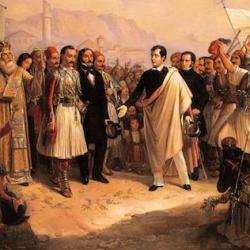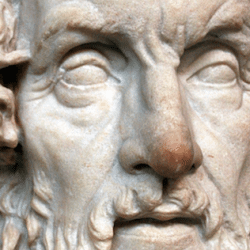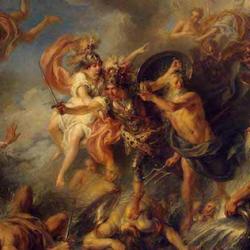In his “Hortatory Address,” Justin claims that Plato’s theory of forms came from a misreading of the tabernacle texts of Exodus:
“And Plato, too, when he says that form is the third original principle next to God and matter, has manifestly received this suggestion from no other source than from Moses, having learned, indeed, from the words of Moses the name of form, but not having at the same time been instructed by the initiated, that without mystic insight it is impossible to have any distinct knowledge of the writings of Moses. For Moses wrote that God had spoken to him regarding the tabernacle in the following words: ‘And thou shalt make for me according to all that I show thee in the mount, the pattern of the tabernacle’ . . .
“And again: ‘And thou shalt erect the tabernacle according to the pattern of all the instruments thereof, even so shalt thou make it.’ And again, a little afterwards: ‘Thus then thou shalt make it according to the pattern which was showed to thee in the mount.’ Plato, then, reading these passages, and not receiving what was written with the suitable insight, thought that form had some kind of separate existence before that which the senses perceive, and he often calls it the pattern of the things which are made, since the writing of Moses spoke thus of the tabernacle: ‘According to the form showed to thee in the mount, so shalt thou make it.’”
Likewise, he believed that Plato’s reference to Jove’s “winged chariot” must have come from the Bible’s descriptions of God’s cherub-chariot and his notion of God as a fiery substance from a misreading of 1 Kings 19:
“For from what other source, if not from his reading the writings of the prophets, could Plato have derived the information he gives us, that Jupiter drives a winged chariot in heaven? For he knew this from the following expressions of the prophet about the cherubim: ‘And the glory of the Lord went out from the house and rested on the cherubim; and the cherubim lift up their wings, and the wheels beside them; and the glory of the Lord God of Israel was over them above.’ And borrowing this idea, the magniloquent Plato shouts aloud with vast assurance, ‘The great Jove, indeed, driving his winged chariot in heaven.’ For from what other source, if not from Moses and the prophets, did he learn this and so write? And whence did he receive the suggestion of his saying that God exists in a fiery substance? Was it not from the third book of the history of the Kings, where it is written, ‘The Lord was not in the wind; and after the wind an earthquake, but the Lord was not in the earthquake; and after the earthquake a fire, but the Lord was not in the fire; and after the fire a still small voice?’ But these things pious men must understand in a higher sense with profound and meditative insight. But Plato, not attending to the words with the suitable insight, said that God exists in a fiery substance.”











